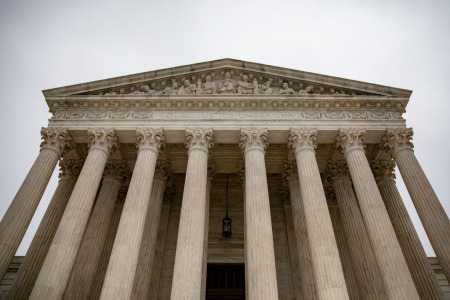Supreme Court strikes down ban on gun bump stocks

The U.S. Supreme Court has struck down a ban administered by the Bureau of Alcohol, Tobacco, Firearms and Explosives on guns that have been modified with bump stocks.
The Supreme Court ruled 6-3 on Friday morning in the case of Garland v. Cargillthat the ATF exceeded its authority by classifying semiautomatic rifles equipped with bump stocks as machine guns, to which access is tightly restricted under federal law.
Justice Clarence Thomas authored the court's opinion, joined by Chief Justice John Roberts, Justices Samuel Alito, Brett Kavanaugh, Amy Coney Barrett and Neil Gorsuch.
Thomas wrote that guns with bump stocks, while modified to fire more easily, still do not operate as machine guns do, thus invalidating their classification as such under federal law.
“A bump stock does not alter the basic mechanics of bump firing. As with any semiautomatic firearm, the trigger still must be released and reengaged to fire each additional shot,” Thomas ruled.
“A bump stock does not convert a semiautomatic rifle into a machinegun any more than a shooter with a lightning-fast trigger finger does. Even with a bump stock, a semiautomatic rifle will fire only one shot for every ‘function of the trigger.’ So, a bump stock cannot qualify as a machinegun.”
Alito authored a short concurring opinion, writing that there was “a simple remedy for the disparate treatment of bump stocks and machineguns.”
“Congress can amend the law — and perhaps would have done so already if ATF had stuck with its earlier interpretation. Now that the situation is clear, Congress can act,” he stated.
Justice Sonia Sotomayor authored a dissenting opinion, being joined by Justices Elana Kagan and Ketanji Brown Jackson. She argued that semi-automatic rifles with bump stocks should be considered machine guns.
“A rifle equipped with a bump stock can fire at a rate between 400 and 800 rounds per minute,” Sotomayor wrote. “A bump-stock-equipped semiautomatic rifle is a machinegun because (1) with a single pull of the trigger, a shooter can (2) fire continuous shots without any human input beyond maintaining forward pressure.”
“The majority’s reading flies in the face of this Court’s standard tools of statutory interpretation. By casting aside the statute’s ordinary meaning both at the time of its enactment and today, the majority eviscerates Congress’s regulation of machineguns and enables gun users and manufacturers to circumvent federal law.”
Under the Trump administration, ATF issued a final rule in 2018 that classified semi-automatic rifles with bump stocks as machine guns, doing so in response to the outcry over the 2017 Las Vegas mass shooting in which a gunman used semi-automatic rifles with bump stocks to kill 60 people and injure 500 others at a concert.
Michael Cargill, a gun owner who surrendered two bump stocks to the ATF in keeping with the regulation but under protest, filed a lawsuit against the government over the rule.
Both the 5th U.S. Circuit Court of Appeals and the 6th U.S. Circuit Court of Appeals ruled against the bump stock ban, while the District of Columbia's appeals court upheld it. Last November, the Supreme Court agreed to hear oral arguments in the case.





















